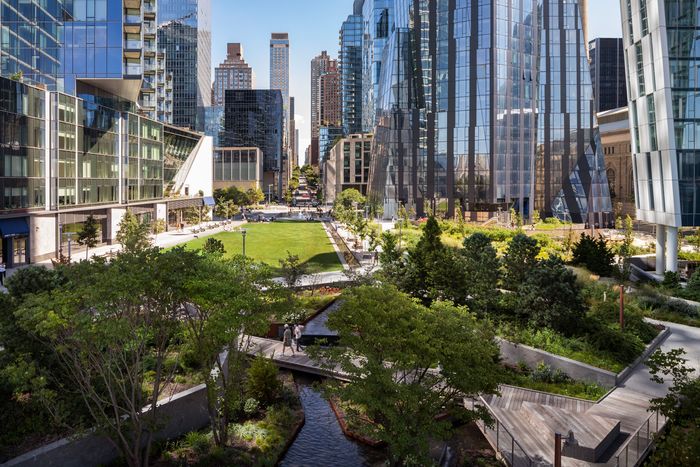
On one of those summer days so hot and thick that the brain goes into standby mode, I duck gratefully into Harry’s Table, the Cipriani-branded Italophile snack shop and grocery at Waterline Square. As I browse the display of three-inch-thick steaks and the vitrine of pies and meringues, I realize that I’m witnessing the outcome of one of the biggest, longest, and most bitterly fought-over real-estate sagas of the last half-century. It’s a sprawling, multi-season series with a panoply of characters that ranges from neighborhood nudniks to a future president. The world’s tallest tower! A teetering highway! Strong-armed mayors! Sinkholes of debt! A new city named for—you guessed it—Trump! The tale has been told as a prequel to the MAGA administration, a chronicle of chaos, cons, and spurious claims of victory. But you can also see it, less operatically, as a slow-burn lesson in disappointment, the triumph of low expectations, and the danger of good intentions.
Back outside is a manicured lawn surrounded by a trio of jagged, excitable glass towers. The weather has sorted the population. I sit at a café table in the shade, along with a handful of hardy adults. The under-12 crowd darts through the hyperactive jets of a fountain embedded in the pavers. Nobody ventures into the playground that steams in the afternoon sun.
Waterline Square is the last puzzle piece in the 57-acre site high above the Hudson River that grew slowly southward from West 72nd Street to West 59th Street, covering what was once an uncrossable swath of rail tracks. Developers salivated over the area starting in the early 1960s and floated an assortment of doomed plans. In 1981, a specially formed joint venture called Lincoln West bought the site with a vision of immense, serried towers that one community board member memorably dismissed as “the Miami Beach Maginot Line.” Then Donald Trump stepped in, with a characteristically grandiose plan to move NBC to a 1,670-foot skyscraper at the western end of West 61st Street, designed by Helmut Jahn, plus 5,700 apartments in a bank of chunky towers.
Trump met two kinds of foes. The first was neighbors who objected to a hyper-mega midtown offshoot springing up outside their living room windows. The developer eventually co-opted his opponents, getting them to sign on to a master plan that called for a swooping skyline of double-towered buildings modeled on the palaces of Central Park West. The second face-off was with Congressman Jerrold Nadler, whose attempt to damage the project by denying federal funds backfired: He succeeded in killing a good plan to tuck the elevated West Side Highway against the cliff and deck it over with a park. (He came at Trump again nearly 30 years later when he served as manager for the second impeachment.) The highway stayed where it was, saving Trump millions and turning the development into a roadside billboard for itself. Now, he said, “when cars go by, they will look at our masterpiece.”
That statement proved accurate, except for the last word. Despite all the dire predictions, the plan did improve, going from worse to bad. But once construction began in the mid-1990s and Trump spun off the property, it soon became clear that the design guidelines were too vague to prevent blandification. An 87-year-old Philip Johnson signed on to co-author just the kind of architecture he cared least about, the stepped-back, Art Deco–ish, resoundingly bourgeois residential building. In the end, it was Trump’s hired gun, Costas Kondylis, who ensured that the lineup would consist of one wide-bodied, blockheaded, value-engineered tower after another.
By 2010, there was still one chunk of land left undeveloped: a two-block stretch just north of West 59th Street, which both the real-estate company Extell and the city’s then–planning chief Amanda Burden were determined to make into a showcase. With Burden’s approval, Extell hired Pritzker Prize winner Christian de Portzamparc (the architect of the elegantly prismatic LVMH tower on East 57th Street and the gruesomely glitzy super-tall One57), who envisioned a cluster of quartzlike glass towers tilting, splitting, and jutting in the finest deconstructionist manner. Once the city approved the project, it changed hands again. This time, though, the executive architects Hill West provided continuity and the design principles were meticulously embedded in the zoning rules. The new developer, GID, brought in three separate marquee firms —Richard Meier Associates, Rafael Viñoly Architects, and Kohn Pedersen Fox — to execute de Portzamparc’s concept. Now that the exquisite corpse of a project, too, is complete, the upshot is graceless but surprisingly satisfying.
New York has some notable examples of roughly homogeneous, master-planned campuses with individual buildings designed by disparate architects: the U.N., Lincoln Center, the World Trade Center, and Hudson Yards come to mind. What’s rarer is for one auteur’s vision to impose itself in such fine-grained detail on other architects of drastically different sensibility. Waterline Square unites architects better known for Cartesian regularity or bulbous monoliths (Viñoly), parched white modernism (Meier), and corporate skyline branding (KPF). The result is a set of dutiful attempts at weirdness, a collage of late-stage deconstructivism by firms that never fully embraced the style.
All that architecture serves to package Waterline Square as the anti-Riverside South: aggressive, fragmented, and crystalline where the Kondylis parade is weighty, predictable, and staid. But perhaps the buildings’ aesthetic trappings are what matter least. For residents, the real premium heart of the development (besides the river views) is the Waterline Club, an underground, oversize ant farm in which to spend their leisure hours.
It used to be that even restless aristocrats with their own pools, pool tables, and ballrooms would still have to leave their gilded premises to play a full-court basketball game, do some light mountaineering, record an album, play doubles, take out the dog, dine in a restaurant, go bowling, or practice a rock to fakie on a half-pipe. Here, it all happens below the street in a leisure complex that joins the three residential buildings. If you live in one of them (and pay an additional membership fee), you can access this wonderworld through a suspended bridge-ramp-staircase combo that seems to levitate in the double-height space like an architectural hologram. Trust the Rockwell Group to turn a quick trip down to the treadmill into a gala-worthy entrance.
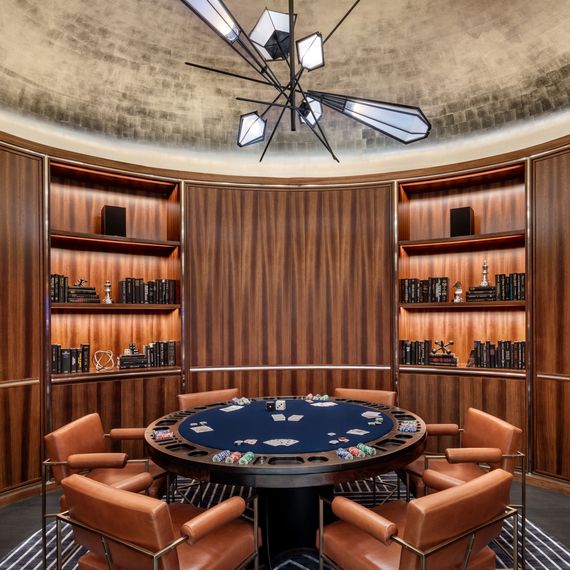
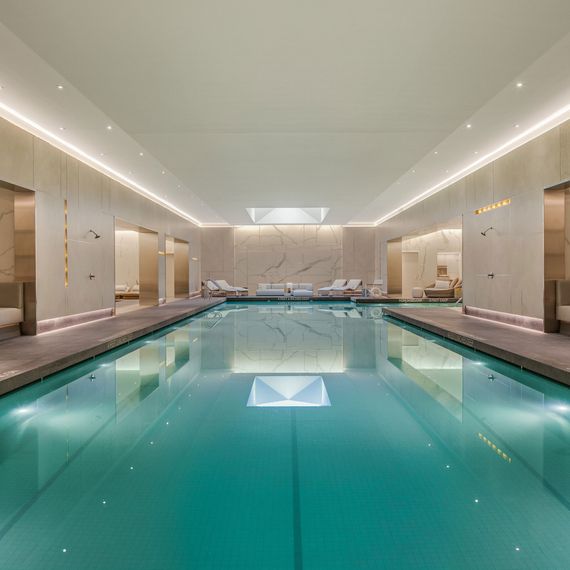
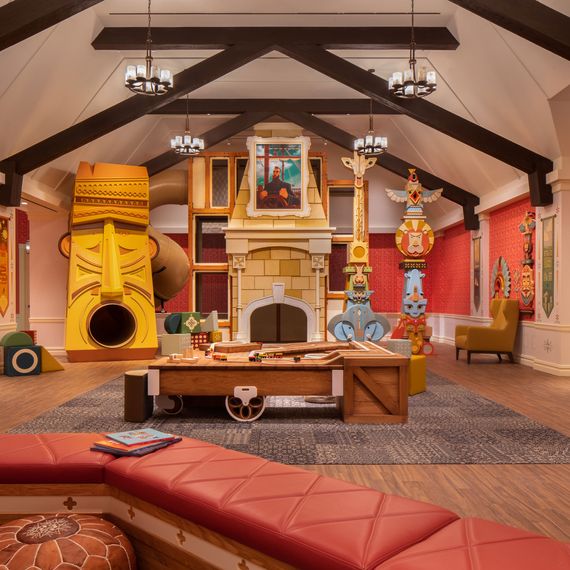
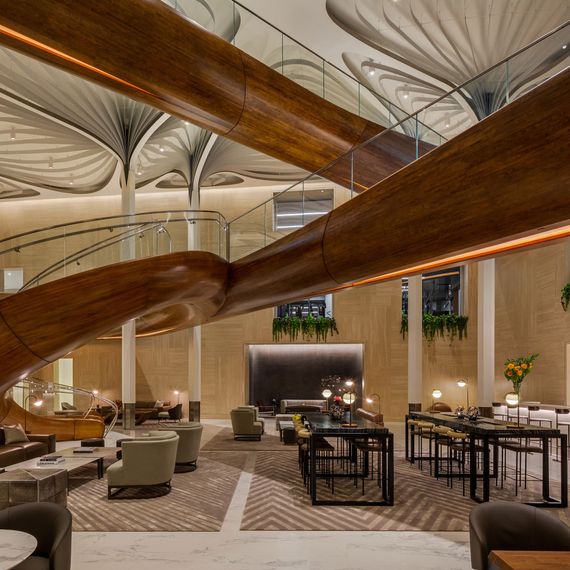
The club’s roof doubles as a landscaped parklet, which is as open and inviting as the amenity cave is exclusionary. Designed by MNLA, a firm that has shaped major chunks of New York’s waterfront, this is Waterline Square’s actual square. For once, the open space — an artful assemblage of lawn, pathways, stream, playground, performance stage, and fountain (with the Cipriani establishment along one flank) — feels like the most felicitous part of the compound. It’s self-contained yet persuasively public, enclosed by buildings but also open to the river, balanced yet asymmetrical. West 60th Street dead-ends at the fountain. There, two walkways fork, leading to Riverside Park South at the top of the cliff, or down the escarpment and under the highway to Hudson River Park. Privately owned public spaces, which make up an ever-larger share of New York’s open areas, often function as perfunctory vestibules to the rentable square footage indoors. Here, the landscaping urges you to pass through and keep going into the sunset. The lumpy crystal mounds of architecture serve as a frame for the part that really counts. That’s the closing twist: Finally, at least some West Siders got a better outcome than just the compromises that their ancestors negotiated.





